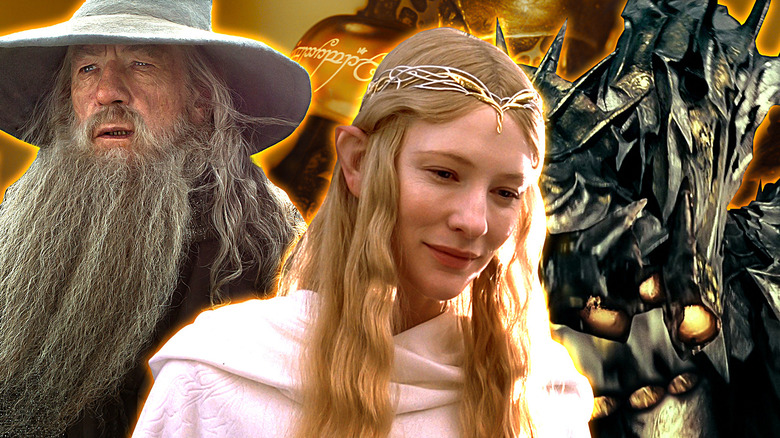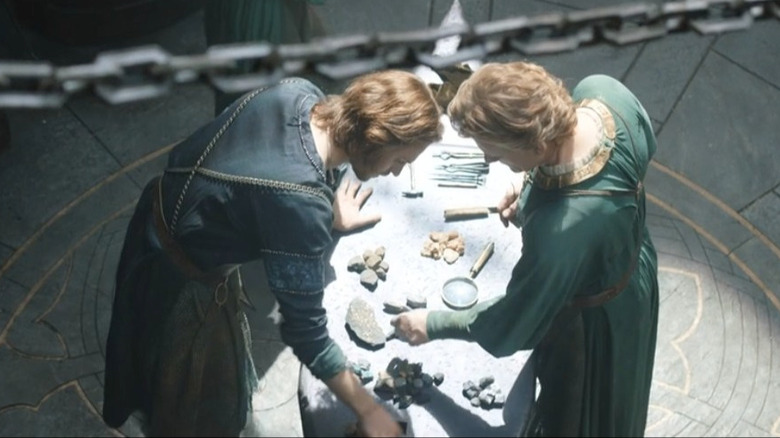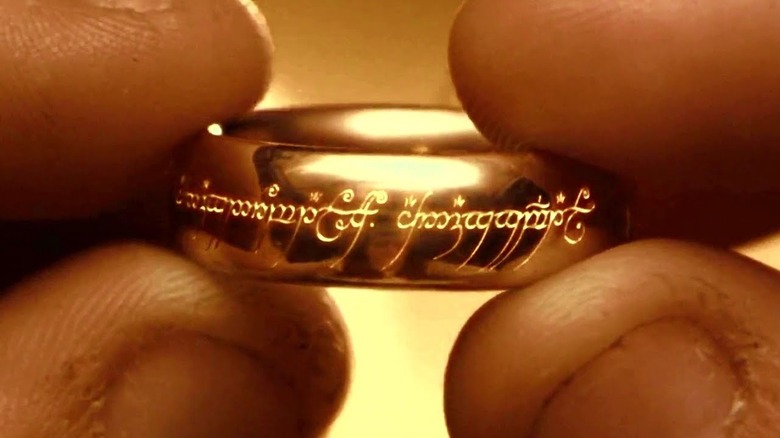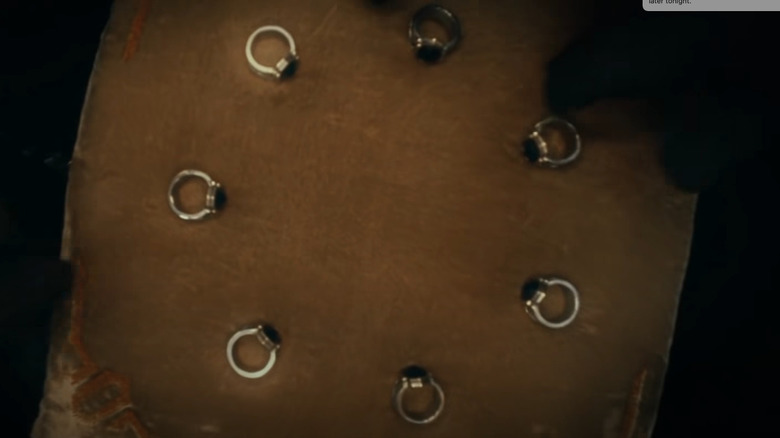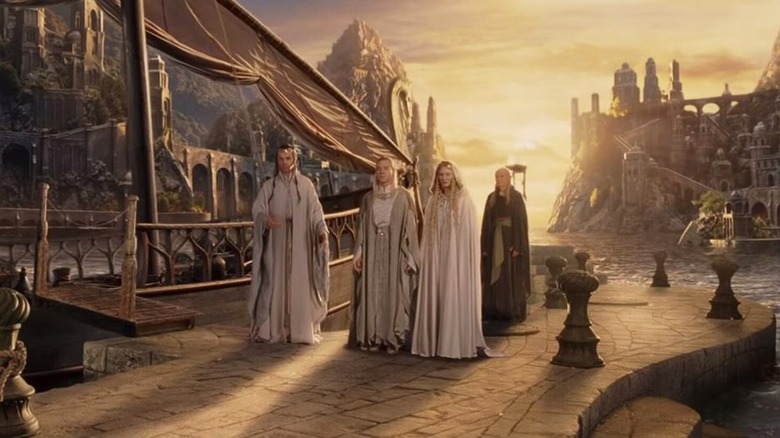What The Rings Actually Do In Lord Of The Rings
J.R.R. Tolkien's world is infused with quiet yet profound magical elements. From a bloodthirsty dragon-killing sword that can talk to the trio of earth-shattering Silmarils, Tolkien loves weaving enchanted items into his Middle-earth tales. One of the most famous ways the Oxford author channels his magical expression is through the 20 Rings of Power. Ultimately distributed to Elves, Dwarves, Men, and the Dark Lord himself, this unique collection of super-powered jewelry has a wild history. Depending on their wearer and purpose, these trinkets have the power to either preserve good and protect against decay or start wars, accumulate wealth, dominate souls, and destroy lives.
That's nice to hear in theory, but how do they work in practice? What do the Rings of Power in Tolkien's mythology actually do? What are their powers? Who created them, and for what purpose? Where are they before and after "The Hobbit" and "The Lord of the Rings" stories?
It's impossible to thoroughly answer these questions. As Gandalf says in the book "The Fellowship of the Ring," "there is only one Power in this world that knows all about the Rings and their effects." While Sauron isn't around to teach us, we can still piece together a general idea of the super-powered jewelry and its effects. Let's take a brief stroll through Middle-earth and consider the unique history of Tolkien's Rings of Power and what it is that makes them so special to everyone who comes in contact with them.
Lord of The Rings: Who Created the Rings and Why?
The Rings of Power aren't around at the beginning of Middle-earth history. The First Age focuses on the three Silmarils, powerful jewel-shaped predecessors to their circular counterparts. It isn't until the Second Age that Tolkien introduces the official Rings of Power. These are created when the skilled Elf Celebrimbor and his fellow craftsman team up with a supernatural ally called Annatar (i.e., Sauron in disguise) to learn his magical skills and craft some rings together. "The Silmarillion" explains, "They took thought, and they made Rings of Power. But Sauron guided their labours, and he was aware of all that they did; for his desire was to set a bond upon the Elves and to bring them under his vigilance."
That last bit is crucial to the reasoning behind the forging of these Rings and what they're meant to do. The Elves desire to create tools that help them understand, heal, and preserve the world around them. The Dark Lord gives them the knowledge to infuse Rings with supernatural powers not to preserve but to control. His plan isn't to use Rings to blast or burn but rather to dominate spirit and soul.
In the end, the Elves and Annatar create 16 rings — these eventually become the nine for mortal Men and seven for the Dwarf-lords. Celebrimbor also forges three rings on his own, which become the Three Elven Rings. Then, Sauron sneaks off to create the One Ring to rule them all. (As a side note, don't be confused by the way "The Rings of Power" writers changed the Tolkien timeline by forging the Three Rings first. In the books, they come at the end, right before the One Ring.)
What does the One Ring in Lord of the Rings actually do, and what are its powers?
The primary function of the One Ring is to dominate those who wear the other Rings of Power. "The Silmarillion" says, "And while [Sauron] wore the One Ring he could perceive all the things that were done by means of the lesser rings, and he could see and govern the very thoughts of those that wore them."
Obviously, the One Ring also extends life indefinitely, although it doesn't simply allow its wearer to continue aging. In the book "The Fellowship of the Ring," Gandalf tells Frodo, "A mortal, Frodo, who keeps one of the Great Rings, does not die, but he does not grow or obtain more life, he merely continues, until at last every minute is a weariness." This goes along with Bilbo's words in that same book when the Hobbit says to the Grey Wizard that he feels thin, stretched, and "like butter that has been scraped over too much bread."
The other unmistakable attribute is that the One Ring makes its wearer invisible — but this is a complicated invisibility. In the book "The Two Towers," Sam puts on the Ring, and the text explains, "The world changed, and a single moment of time was filled with an hour of thought. At once he was aware that hearing was sharpened while sight was dimmed." It adds that in that grey, hazy world, "he did not feel invisible at all, but horribly and uniquely visible." Sam is also able to understand Orc speech, and the book explains, "Perhaps the Ring gave understanding of tongues, or simply understanding, especially of the servants of Sauron its maker, so that if he gave heed, he understood and translated the thought to himself."
What powers and abilities do the other Rings of Power have?
Sauron divvies up the 16 Rings of Power that he captures from Celebrimbor and Company, famously giving nine to Mortal Men and seven to Dwarf-lords. The Men are the easiest for him to control with his will — so much so that they remain his servants even after he loses the One Ring. "The Silmarillion" summarizes that Men were easy to ensnare, and those who wield the Nine Rings became mighty and immortal. It says, "they obtained glory and great wealth, yet it turned to their undoing," adding a bit later that one by one, "they fell under the thraldom of the ring that they bore and under the domination of the One, which was Sauron's." Right before this, the text explains that "the Dwarves indeed proved tough and hard to tame," adding that "they used their rings only for the getting of wealth; but wrath and an over-mastering greed of gold were kindled in their hearts." It also reports, "It is said that the foundation of each of the Seven Hoards of the Dwarf-kings of old was a golden ring."
The Elven rings are where things take a turn for the better. Their masters are stronger than expected, and they manage to get their rings off and hide them before Sauron attacks and captures the rest. They keep their Rings hidden, and at the Council of Elrond in the book "The Fellowship of the Ring," Elrond summarizes their status. He says that the Three are still at work. (At that point they are being worn secretly while Sauron has lost his One Ring.) He adds, "Those who made them did not desire strength or domination or hoarded wealth, but understanding, making, and healing, to preserve all things unstained."
What Happens to the Rings at the End of Lord of the Rings?
Unfortunately, anyone looking for a rock-solid, scientific explanation of what the Rings of Power do is in for disappointment. There are a few vague benefits, such as invisibility, translation, or semi-immortality. But by and large, Tolkien kept these magical, spiritual tools and their most important capabilities shrouded in mystery.
So, what happens to all of these enigmatic super-weapons at the end of the story? The One Ring is the easy one: it's destroyed in the fires of Mount Doom. Gandalf, Galadriel, and Elrond, the Keepers of the Three Rings of Power, end up riding to the sea and setting sail off into the west (that's the scene at the end of Peter Jackson's "The Lord of the Rings" trilogy.)
As for the Nine Rings, when the One Ring is destroyed, the book "The Return of the King" says, "And into the heart of the storm, with a cry that pierced all other sounds, tearing the clouds asunder, the Nazgûl came, shooting like flaming bolts, as caught in the fiery ruin of hill and sky they crackled, withered, and went out." Presumably, their fiery deaths took their rings with them.
The last group is the Dwarven-rings. Of them, "The Silmarillion" explains their fate along with the unpleasantly accumulated wealth of their owners, saying, "but all those hoards long ago were plundered and the Dragons devoured them, and of the Seven Rings some were consumed in fire and some Sauron recovered." Those surviving Dwarven Rings of Power are the only loose ends in the book. While nothing is said of their fate, it seems safe to assume they end up in a similar condition to those of the Nazgûl.
